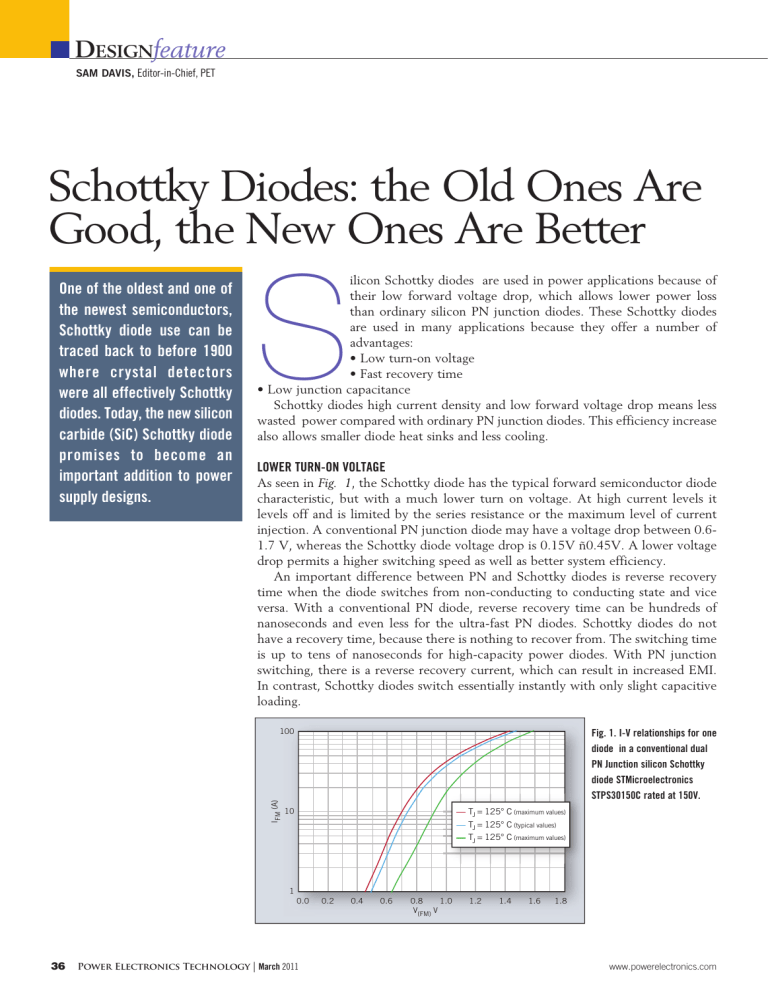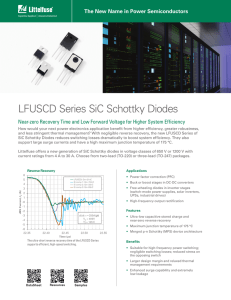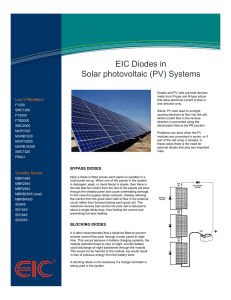Schottky Diodes: the Old Ones Are Good, the

D
ESIGN feature
SAM DAVIS, Editor-in-Chief, PET
Schottky Diodes: the Old Ones Are
Good, the New Ones Are Better
One of the oldest and one of the newest semiconductors,
Schottky diode use can be traced back to before 1900 where crystal detectors
S ilicon Schottky diodes are used in power applications because of their low forward voltage drop, which allows lower power loss than ordinary silicon PN junction diodes. These Schottky diodes are used in many applications because they offer a number of advantages:
• Low turn-on voltage
• Fast recovery time
• Low junction capacitance
Schottky diodes high current density and low forward voltage drop means less wasted power compared with ordinary PN junction diodes. This efficiency increase
were all effectively Schottky diodes. Today, the new silicon carbide (SiC) Schottky diode
also allows smaller diode heat sinks and less cooling.
promises to become an important addition to power supply designs.
LOWER TURN-ON VOLTAGE
As seen in Fig. 1 , the Schottky diode has the typical forward semiconductor diode characteristic, but with a much lower turn on voltage. At high current levels it levels off and is limited by the series resistance or the maximum level of current injection. A conventional PN junction diode may have a voltage drop between 0.6-
1.7 V, whereas the Schottky diode voltage drop is 0.15V ñ0.45V. A lower voltage drop permits a higher switching speed as well as better system efficiency.
An important difference between PN and Schottky diodes is reverse recovery time when the diode switches from non-conducting to conducting state and vice versa. With a conventional PN diode, reverse recovery time can be hundreds of nanoseconds and even less for the ultra-fast PN diodes. Schottky diodes do not have a recovery time, because there is nothing to recover from. The switching time is up to tens of nanoseconds for high-capacity power diodes. With PN junction switching, there is a reverse recovery current, which can result in increased EMI.
In contrast, Schottky diodes switch essentially instantly with only slight capacitive loading.
100 Fig. 1. I-V relationships for one diode in a conventional dual
PN Junction silicon Schottky diode STMicroelectronics
STPS30150C rated at 150V.
T
J
= 125° C (maximum values)
T
J
= 125° C (typical values)
T
J
= 125° C (maximum values)
10
1
0.0 0.2 0.4 0.6 0.8 1.0 1.2 1.4 1.6 1.8
V
(FM)
V
36 Power Electronics Technology |
March 2011 www.powerelectronics.com
The Schottky diode is a “majority carrier” semiconductor. If the semiconductor body is doped n-type, only the n-type carriers (mobile electrons) play a significant role in normal operation of the device. Majority carriers are quickly injected into the conduction band of the metal contact on the other side of the diode to become free moving electrons. Therefore, the diode can cease conduction faster than an ordinary PN diode. This property allows a smaller device area, and a faster transition. One reason why Schottky diodes are useful in switch-mode power supplies is that the high speed of the diode means that the circuit can operate at frequencies from 200 kHz to
2 MHz. This allows use of lower value and smaller size inductors and capacitors.
A limitation of Schottky diodes is their relatively low reverse voltage rating for silicon-metal Schottky diodes.
Reverse leakage current, because it increases with temperature, can lead to a thermal instability issue. This often limits the useful reverse voltage to well below the actual rating.
In summary, Schottky diode s:
• Have a much higher reverse leakage current than standard PN junction diodes.
• Maximum junction temperature is normally limited to the range 125°C to 175°C, compared with 200°C for silicon diode rectifiers.
• Have a limited reverse voltage capability, with a maximum typically around 100 V.
2.0
1.8
1.6
1.4
1.2
1.0
0.8
0.6
0.4
0.2
0.0
0.0 0.5 1.0 1.5 2.0
V
F
Forward Voltage (V)
T
J
= 25° C
T
J
= 50° C
T
J
= 100° C
T
J
= 150° C
2.5 3.0 3.5
Fig. 2. I-V relationships in a Cree CSD01060 SiC Schottky diode rated at 600 V. various AC input sources worldwide. In existing data center power architectures, 3-phase/480V power is supplied from the local utility. This 3 phase/480V power is converted to 3 phase/208V by means of a power transformer and then further conditioned to provide input power to the server power supply. Transformer losses reduce overall power supply efficiency.
SIC SCHOTTKY DIODES
Within the last decade, silicon carbide (SiC) Schottky diodes have become available in 300 V to 1700 V versions. An SiC Schottky diode has about 40 times lower reverse leakage current compared with PN silicon Schottky diodes. Silicon carbide has a high thermal conductivity and temperature has little influence on its switching and thermal characteristics. With special packaging, it is possible to have operating junction temperatures of over 500
K, which allows passive radiation cooling in aerospace applications.
Standard silicon diodes have a forward voltage drop of about 0.6 V and germanium diodes 0.3 V. Fig. 2 shows the
I-V relationship of a typical SiC Schottky diode.
Cree, Inc. has announced a new line of 650V SiC
Schottky diodes that accommodate recent changes in data center power architecture that industry consultants estimate will result in energy efficiency gains of up to 5 percent. Because data centers account for nearly 10 percent of the world’s annual consumption of electrical power, any efficiency gain represents a significant opportunity to reduce overall power consumption.
Conventional switch-mode power supplies typically have an input voltage range of 90V - 264V, supporting
UNIVERSAL INPUT
Recent trends in data center power architecture call for the elimination of the 480V to 208V conversion to boost overall data center efficiency. Instead of providing
120V AC from the 3- phase/208V line to neutral, server power supplies will now be expected to accept a broader universal line voltage range of 90V - 305V (277V plus a
10 percent guard band) directly from the 3-phase/480V line to neutral. This architecture eliminates the need for the step-down power transformer, along with the related energy losses and expense.
Optimal operation of server power supplies with a higher input voltage range of 90V - 305V requires power components such as Schottky diodes that have an extended maximum blocking voltage of 650V. Cree’s new 650V-rated devices provide this solution for designers of state of the art power supplies for data center servers and communications equipment. These silicon carbide diodes not only feature the 650V blocking voltage needed for these advanced power supplies, but they also further reduce energy losses, compared with silicon devices, by eliminating reverse recovery losses.
Initial products in the 650V Schottky diode family, the www.powerelectronics.com
March
2011 | Power Electronics Technology 37
SCHOTTKY
diodes
C3DXX065A Series, include 4, 6, 8, and 10 A versions in TO-220-2 packages. Operating temperature range is
-55°C to +175°C.
Cree, Inc. also announced the industry’s first commercially available 1700-V Schottky diode products.
Leveraging silicon carbideís unique advantages over silicon to virtually eliminate diode switching losses, these diodes are targeted at high-voltage power-conversion applications in motor-drive, wind-energy and traction systems.
Initial products in the 1700 V series include 10 A and
25 A Schottky diodes in die form, ready for integration into 1700 V power modules ranging from 50 to 600 A.
The new 1700 V diode series can increase the efficiency, reliability and longevity of power systems while also reducing the overall system size, weight and cost.
In 2010, Infineon Technologies announced availability of its second generation SiC Schottky diodes in the
TO-220 FullPAK package. The new TO-220 FullPak adds the advantage of a fully isolated package, including easier and more reliable mounting without having to use isolating bushings and foil.
The TO-220 FullPAK devices show a similar junctionto-heatsink thermal resistance as the standard non-isolated
TO-220 devices. This is accomplished by using patented diffusion soldering technique, which strongly reduces the
“chip-to-leadframe” thermal resistance and effectively compensates for the FullPAK´s internal isolation layer.
Infineon offers the 600V FullPAK portfolio in current ratings from 2A to 6A. These SiC Schottky diodes are offered in 600V and 1200V types.
V
R
= 400 V, I
F
= 8 A, T
J
= 125° C, di/dt = 200 A/microsecond
SiC
Tandem STTH806DT1
Si
Reverse recovery comparison
Fig. 3. Comparison of recover times for STMicroelectronics Schottky diodes.
A typical PN Schottky diode, ultra-fast STTH806DTI PN Schottky diode and an
STPSC606D SiC Schottky diode. usable power. In high-power applications, heatsinks can be made smaller, leading to more compact power supplies delivering higher power density.
A further benefit for SMPS designers is that SiC diodes allow higher switching frequencies, which enable other components such as lower value filter capacitors and inductors to become smaller and less expensive, and consume less power.
POWER FACTOR CORRECTION
Active power factor correction has been widely adopted in AC/DC switch-mode power supply (SMPS) designs due to the mandatory IEC-61000-4-3 requirements since
January 2001. For SMPS with output power rating higher than 300W, the active PFC boost converters are normally designed to operate in continuous conduction mode (CCM).
SiC Schottkys are ideal for this application.
During the PFC’s boost diode turn-off and boost MOSFET turn-on transition, excessive reverse recovery current in a silicon diode contributes to the switching loss in the diode itself. It also impacts the MOSFET turn-on switching loss, which leads to the requirement of larger die devices for both
MOSFET and boost diode in order to meet efficiency and thermal specifications.
Ordinary silicon diodes used in switch-mode power supplies lose up to 1% efficiency by not turning off immediately. SiC diodes can save that energy normally lost during switching. By saving the energy normally dissipated as heat by the silicon diode, SiC technology enables a lower maximum current rating for the diode. This allows the use of smaller circuit components without having to sacrifice
NO REVERSE RECOVERY CHARGE
SiC technology delivers these benefits because no reverse recovery charge accumulates during the diode’s normal conduction period. When a conventional bipolar silicon diode is turned off, this charge must be dispelled by recombination between groups of charge carriers close to the diode junction. The current flowing during this recombination period is called the reverse recovery current. This undesired current, when combined with the voltage across associated semiconductor power switches, generates heat that will be dissipated by the switches.
By eliminating this reverse recovery charge, SiC
Schottky diodes have much lower switching losses across the board, leading to higher efficiency and lower heat dissipation. Fig. 3 compares the reverse recovery of conventional PN Schottky, an ultra-fast recovery silicon and an SiC Schottky.
Tests have shown efficiency improvements of +0.5%, and up to +1% at high load and high frequency when using a SiC Schottky diode. The second direct improvement is the power density through the reduced mechanical size of the magnetic elements as a result of the potential increase in the switching frequencies when using SiC diodes.
Finally, the noise-free characteristic of SiC diodes allows the use of smaller EMI filters. This further increases power density.
38 Power Electronics Technology |
March
2011 www.powerelectronics.com

